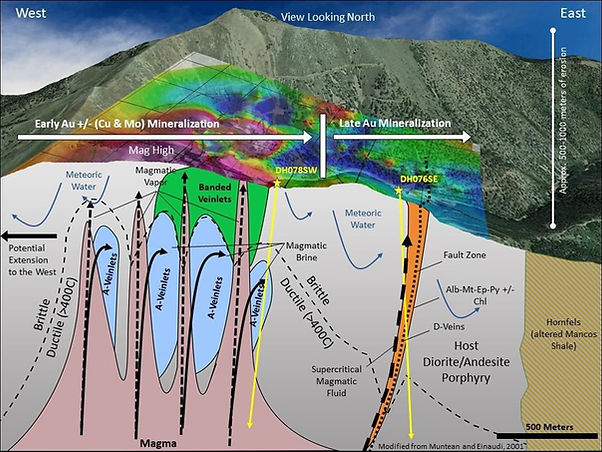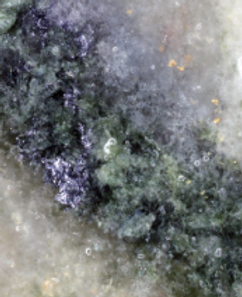
Geology
Prolific Mining Henry Mountains Utah deposit consists of two deposit types: a structure hosted gold system that is adjacent to and overlies a Maricunga-style porphyry gold system similar to that found in the Maricunga Gold Porphyry Belt in northern Chile.

Magma Chamber
Located deep beneath the surface.
Responsible for heat and fluid generation.
Associated with supercritical magmatic fluids, vapors, and brines.
Veining and Alteration Zones
• A-Veinlets:
Formed from magmatic brine, rise vertically and fan out. Contain Cu-Au-Mo mineralization. Banded Veinlets: Central green zone, commonly related to intense alteration and high-grade mineralization.
•D-Veins:
Associated with Albite-Magnetite-Epidote-Pyrite ± Chlorite alteration.
• Host Rock:
Diorite/Andesite Porphyry intruded into the host sequence, experiencing intense alteration.
Magmatic Brine and Vapor:
Ascend from magma and contribute to mineralization and hydrothermal alteration.
Meteoric Water:
Circulates from surface, mixes with magmatic fluids, and influences alteration and mineral deposition.
Supercritical Magmatic Fluid:
Indicated beneath brittle-ductile boundary (~400°C), crucial for high-temperature alteration.

Mineralization

Mineralization across the Prolific Mining Henry Mountains Utah Deposit occurs as stockworks, veins and surface structures. The stockwork is found on the surface in outcrop and consists of networks of banded quartz and quartz-sulphide veinlets.
The banded stockwork veinlets consist of either magnetite or dark quartz (inclusion rich) forming along boundaries or as discrete bands in quartz veins.
The larger veins found in outcrop and within drill core are primarily steeply north trending parallel banded A-type banded quartz veins ranging in width from 1.0 to 10 cm. There are also B-type veins hosting sulphides (pyrite- chalcopyrite-bornite-molybdenite) in a central vein suture.
Porphyry Mineralization
The porphyry mineralization is defined where sulphide and oxide mineralization are present as disseminated grains and accumulations in altered rock and in localized networks of fracture-controlled quartz veins (A-type and B-type) +/- magnetite pyrite veins (M-type).
Various types of hydrothermal alteration and mineralization are genetically related to magma reservoirs, predominantly felsic to intermediate in composition. The currently explored portion of the Henry Mountains porphyry deposit shares many similarities to the Maricunga Gold Porphyry Belt. The veins found across the Deposit and in the cores are consistent with other gold porphyry systems,namely a sequence of M-type veins, banded quartz A- type veins and sulphide bearing B-type veins.

